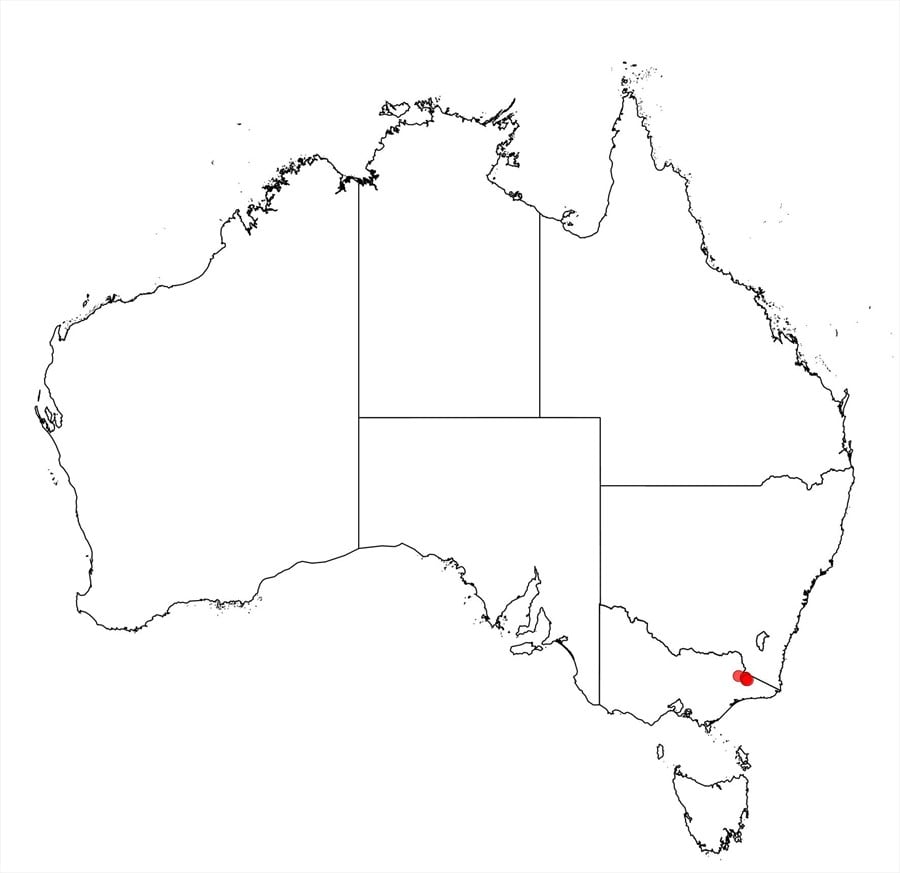Acacia nanopravissima Molyneux & Forrester
WATTLE
Acacias of Australia
Common Name
Little Kooka Wattle
Family
Fabaceae
Distribution
Known only from type locality, Splitters Ck, S of Wulgulmerang in East Gippsland, Vic. Currently known by a single small population on the Wombargo Ra. in the upper catchment of Little R., a tributary of the Snowy R. The population comprises small fragmented stands in close proximity extending across a slope overlooking and S of Splitters Ck, a tributary of Little R.; an isolated stand of five plants occurs just E of the Splitters Ck subpopulation.
Description
Erect shrub 0.4–0.6 (–1) m high, readily suckering. Branchlets glabrous. Phyllodes crowded, markedly inequilateral, generally obdeltate with adaxial margin conspicuously rounded and its proximal edge ±parallel to branchlet, 3–8 mm long, 4–8 mm wide, mucronulate, grey-green, glabrous; imperfectly 2-nerved, lateral nerves not anastomosing; gland prominent, (1.6–) 2.3–3.7 (–4.5) mm above pulvinus, similar in form to A. kettlewelliae. Inflorescences (6–) 8–10-headed racemes; raceme axes (0.5–) 1.2–2.7 (–6) cm long (exceeding the phyllodes); peduncles 2–4 mm long, glabrous; heads globular, 3–4 mm diam. (dry), 7–9-flowered, golden. Flowers 5-merous; sepals united. Pods and seeds not seen.
Phenology
Flowers late Aug.–early Oct.
Habitat
Grows in dry open forest on high rocky ground in shallow soils derived from sediments.
Specimens
Vic.: Wulgulmerang, Little R., 15 Jan. 1971, A.C.Beauglehole s.n. (MEL 563409); Splitters Ck, Wulgulmerang, 11 Jan. 1949, N.A.Wakefield s.n. (MEL 544638); Splitters Ck crossing, Limestone Ck Rd, 22 Sep. 1990, W.M.Molyneux & S.G.Forrester s.n. (MEL 1587015).
Notes
A slow growing dwarf species that spreads by suckering; plants do not seem to set fruit. It was treated as a dwarf variant of A. pravissima by B.R.Maslin in Fl. Australia 11A: 331 (2001). Acacia infecunda and A. tabula occur in the same area and were treated as dwarf variants of A. boormanii and A. buxifolia subsp. buxifolia in Fl. Australia 11A: 334 & 341 (2001) respectively.
Most closely related to A. pravissima which differs in its taller stature, generally larger phyllodes and larger heads, see W.M.Molyneux & S.G. Forrester (Muelleria 26(1): 54, Table 1 (2008), Table 1) for a detailed comparison of these two species. According to W.M.Molyneux & S.G. Forrester (Muelleria 26(1): 56 (2008) the nearest stands of A. pravissima to those of A. nanopravissima are on the upper Gibbo R., some 90 km to the NW.
FOA Reference
Flora of Australia Project
Author
B.R.Maslin
This identification key and fact sheets are available as a mobile application:
URL: https://apps.lucidcentral.org/wattle/
© Copyright 2018. All rights reserved.







